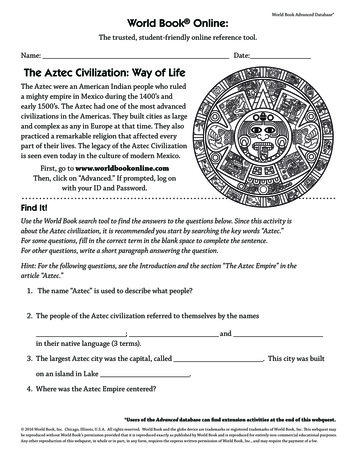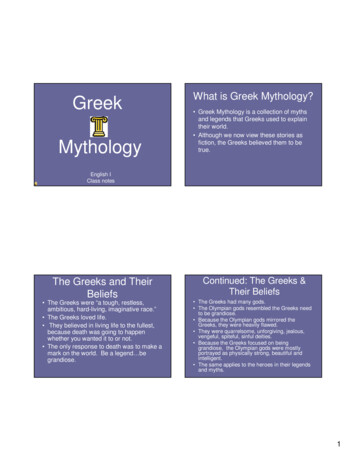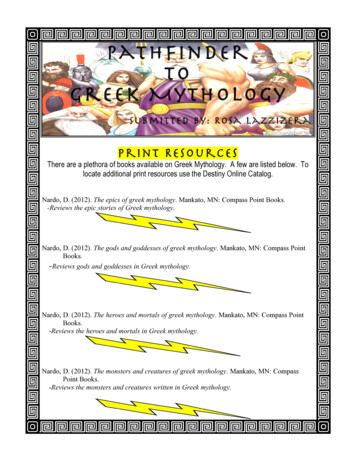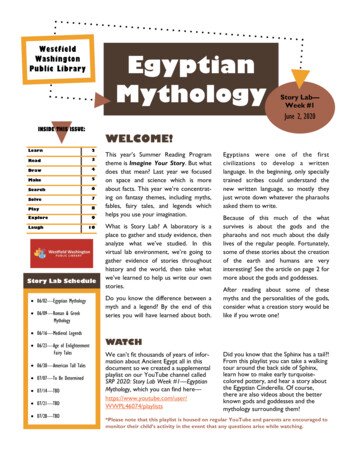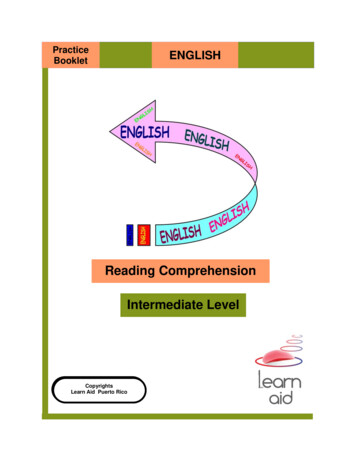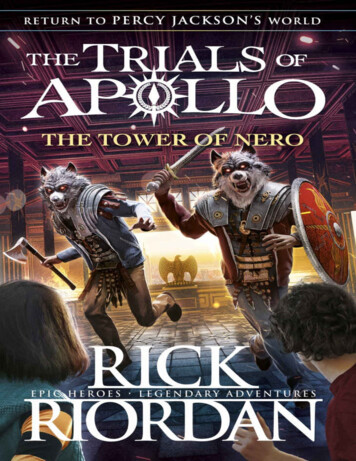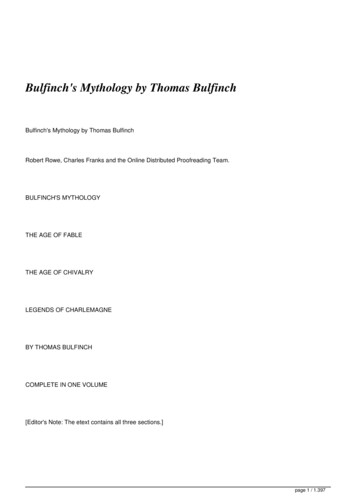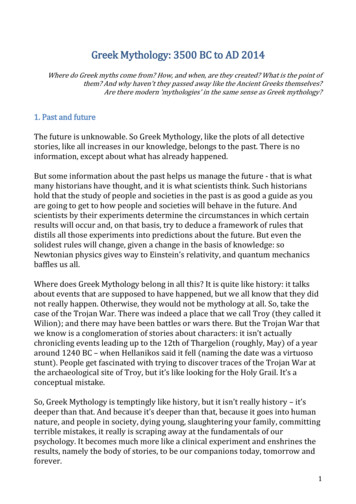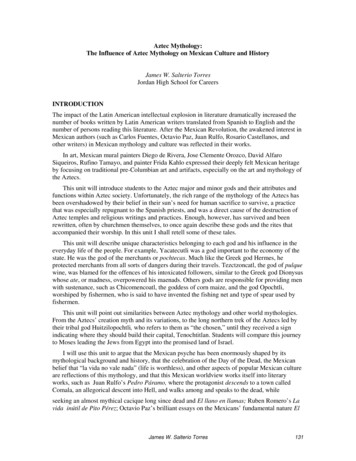
Transcription
Aztec Mythology:The Influence of Aztec Mythology on Mexican Culture and HistoryJames W. Salterio TorresJordan High School for CareersINTRODUCTIONThe impact of the Latin American intellectual explosion in literature dramatically increased thenumber of books written by Latin American writers translated from Spanish to English and thenumber of persons reading this literature. After the Mexican Revolution, the awakened interest inMexican authors (such as Carlos Fuentes, Octavio Paz, Juan Rulfo, Rosario Castellanos, andother writers) in Mexican mythology and culture was reflected in their works.In art, Mexican mural painters Diego de Rivera, Jose Clemente Orozco, David AlfaroSiqueiros, Rufino Tamayo, and painter Frida Kahlo expressed their deeply felt Mexican heritageby focusing on traditional pre-Columbian art and artifacts, especially on the art and mythology ofthe Aztecs.This unit will introduce students to the Aztec major and minor gods and their attributes andfunctions within Aztec society. Unfortunately, the rich range of the mythology of the Aztecs hasbeen overshadowed by their belief in their sun’s need for human sacrifice to survive, a practicethat was especially repugnant to the Spanish priests, and was a direct cause of the destruction ofAztec temples and religious writings and practices. Enough, however, has survived and beenrewritten, often by churchmen themselves, to once again describe these gods and the rites thataccompanied their worship. In this unit I shall retell some of these tales.This unit will describe unique characteristics belonging to each god and his influence in theeveryday life of the people. For example, Yacatecutli was a god important to the economy of thestate. He was the god of the merchants or pochtecas. Much like the Greek god Hermes, heprotected merchants from all sorts of dangers during their travels. Tezctzoncatl, the god of pulquewine, was blamed for the offences of his intoxicated followers, similar to the Greek god Dionysuswhose ate, or madness, overpowered his maenads. Others gods are responsible for providing menwith sustenance, such as Chicomencoatl, the goddess of corn maize, and the god Opochtli,worshiped by fishermen, who is said to have invented the fishing net and type of spear used byfishermen.This unit will point out similarities between Aztec mythology and other world mythologies.From the Aztecs’ creation myth and its variations, to the long northern trek of the Aztecs led bytheir tribal god Huitzilopochtli, who refers to them as “the chosen,” until they received a signindicating where they should build their capital, Tenochtitlan. Students will compare this journeyto Moses leading the Jews from Egypt into the promised land of Israel.I will use this unit to argue that the Mexican psyche has been enormously shaped by itsmythological background and history, that the celebration of the Day of the Dead, the Mexicanbelief that “la vida no vale nada” (life is worthless), and other aspects of popular Mexican cultureare reflections of this mythology, and that this Mexican worldview works itself into literaryworks, such as Juan Rulfo’s Pedro Páramo, where the protagonist descends to a town calledComala, an allegorical descent into Hell, and walks among and speaks to the dead, whileseeking an almost mythical cacique long since dead and El llano en llamas; Ruben Romero’s Lavida inútil de Pito Pérez; Octavio Paz’s brilliant essays on the Mexicans’ fundamental nature ElJames W. Salterio Torres131
laberinto de la soledad; Agustin Yanez’s Al filo del agua; Carlos Fuentes’ La muerte de ArtemioCruz; and other Mexican writings.Students will discuss specific authors who have used Aztec mythology, in one form oranother in their writings, including the Chilean Nobel prize-winning poet Pablo Neruda in hisCanto General. Students will discuss the mythological elements in Carlos Fuentes’ sciencefiction story Chac Mol, even though the story deals with a Mayan, not an Aztec, deity.This unit is written for a 12th grade Advanced Placement course in Spanish and SpanishAmerican Literature. It will expose my Spanish AP students to Mesoamerican mythology,allowing them to study and compare the similarities and differences with the better-knownclassical Greek and Roman myths. Students will study and use handouts and visual aids, that is,illustrations of the gods taken from the various codices.This unit will be taught completely in Spanish; therefore, all of the material in the unit will betranslated into Spanish.OBJECTIVESThis unit will meet the following Project Clear for Languages Other Than English (ForeignLanguage) objectives:Goal 1: Communication (Reading) 9.1.h Students will read to discover meaning through contextand visual clues.Goal 1: Communication (Writing) 9.1.i Students will write in the target language to convey amessage or to exchange information about everyday activities or oneself.Goal 2: Cultures: 9.2.a Students will describe some of the daily activities of the people of thetarget language and how this is reflected in their culture and language.9.2.b Students will locate the major countries and areas of the world where the target language isspoken and identify some well-known personalities as well as some of the characteristicsof the people.Goal 3: Connections: 9.3.a Students will use the language to make connections with other subjectareas and to acquire information.Goal 4: 9.4.a Students will compare and contrast one language and culture to another languageand culture.UNIT BACKGROUNDForewordDesde ‘ab inicio’ adoramos nuestros dioses y los tenemos por buenos, así deben ser losvuestros y no cureis más al presente de hablarnos de ellos./Throughout all time we haveworshipped our own gods and thought they were good. I do not doubt the goodness of thegod whom you worship, so do not trouble to speak to us about them at present. (Díaz delCastillo 317)Moctezuma’s words to Cortes contain the seed for the destruction of the Aztec religioussystem by the Spanish Catholic Church. The religious intolerance of the Spaniards, which hadbeen reinforced by their long and bloody reconquista of Spain from the Moors, ending with theexpulsion of the Moors and the Jews from Spain in 1492, was in sharp contrast to the Aztecreligion, which had already incorporated a great number of ancient Mesoamerican gods into itspantheon. Edith Hamilton contrasts the gods of the Greeks with those of primitive man asfollows:132Houston Teachers Institute
Horrors lurked in the primeval forest, not nymphs and naiads. Terror lived there, with itsclose attendant, Magic, and its most common defense, Human Sacrifice These and theirlike were what the pre-Greek world worshipped. One only need place beside them inimagination any Greek statue of a god, so normal and natural with all its beauty, toperceive that a new idea had come into the world. With its coming, the universe becamerational. (4, 8)It is precisely the Aztec’s desire to make their world rational that gave rise to many, even themost terrifying of their myths. Many of the Aztec gods are agricultural gods, and the need toappease these gods through ritualistic planting and sacrifices is shared by cultures that depend onagriculture. The Aztec’s creation myths are an attempt to explain the origins of the universe andof man. Unfortunately for the Aztecs, human sacrifice, the most disgusting ritual, is normally thefocus of a study of the Aztecs and their religion.The Aztec religion was polytheistic and some of the anthropomorphic gods in the Mexicanpantheon were originally human heroes elevated to divine stature, for example TopiltzinQuetzalcoatl of Tula and Mixcoatl among the Chichimecs. Mesoamerican religion is pervasive inevery aspect of their culture. In a very crowded pantheon it is difficult to assign lordship over adistinct sphere – sun, moon, maize, pulque or earth – to one specific god. To add more confusion,the Aztec gods often have a number of avatars (e.g. Quetzalcoatl, Ehecatl, XolotlTlahuizcalpentecuhtli).In the end, the Spaniards destroyed Indian libraries, temples, and idols, and other religiousmanifestations of the Mesoamerican Indians. Most of the accounts and descriptions of the Aztecsand Mayan gods that have survived are seen through a Hispanic prism. But, you only have toattend the Catholic rituals in some of the regions populated by the descendants of the Aztecs andthe Maya in Mexico and Central America and of the Incas in Peru, and you will witness thepower these religions had to assimilate the gods of other cultures. The semblance may be anormal Catholic mass, but it is always refreshing to see that the conqueror’s religion has beenassimilated into the religion of the conquered, which has discovered under the guise of the saintsand prophets of the Catholic faith many of their old, familiar gods. They are as familiar to them aswhen an old, Mexican peasant still addresses corn, the sacred plant, as “Your Lordship.”The Origin of the AztecsAbout nine hundred years ago, a tribe of Native Americans called the Aztecs were told bytheir gods that to the south lay a fertile land where they would found a great city. Led by theirtribal god Huitzilopochtli, they abandoned their homeland, reportedly Chicomoztoc, or SevenCaves, or, according to other accounts, from another place called by different names, Aztlan andAzcatitlan, probably located in northwestern Mexico. Modern researchers have not been able tolocate this site. According to legend, eight different tribes abandoned this site, among them theMexica-Azteca.Huitzilopochtli smeared resin on their ears and foreheads and stuck balls of feather-down onthem as a sign that they were his chosen people. The god also commanded them to change theirname from Aztecs to Mexica. They began an arduous three-hundred-year journey southward insearch of a new place to live.About AD1250 the Aztecs arrived and settled in Chapultepec, or Grasshopper Hill, but theymade many enemies among the surrounding tribes by stealing their married women and becauseof their repugnant sacrifices. They were driven from Chapultepec and forced to hide in theswamps surrounding the Lake of Tezcoco (Lake of the Moon). Later, they settled in some smallislands in the Lake of Tezcoco, near what is now Mexico City.James W. Salterio Torres133
The fertile highland valley in which they settled had been under the rule of the Toltecs whohad consolidated their power gradually in the area after founding their capital Tula about AD 950.The Toltecs enjoyed a rich legacy of myths and legends. In 1168, the Chichimecs destroyed thecity of Tula and Toltec rule came quickly to an end. When the Aztecs arrived in the Valley ofMexico, they found several tribes living in the area, but after the fall of the Toltecs no dominantpower had risen to take their place. The Toltecs’ influence over the Aztecs, however, wassignificant because the Aztecs adopted their culture, including their myths and legends. Ashistorian Nigel Davies puts it:Basic to the Mexica version of their history is the reported intermarriage of their elitewith the Culhua nobility, par excellence, the guardians of the Toltec tradition. Thisinjection of Culhua blood served the Mexica as a pretext, however contrived, to pose asthe true heirs of Tula, depicted in Aztec legend as a fabulous city whose temples werefaced with gold and turquoise. By virtue of this claim, in their future career of conquestthey were merely regaining what was theirs by right, as the ‘Colhua Mexica,’ or thelatter-day Toltecs. (224)Religion permeated every aspect of Aztec life. The Aztecs assimilated many of the gods fromother cultures into their pantheon, including such vital gods as Quetzalcoatl and Tlaloc, andothers, from early Mesoamerican cultures, such as the Toltecs and other neighboring tribes.As the chosen people of the Sun God Huitzilopochtli, the Aztecs had the divine mission tofeed the god the hearts and blood needed to make sure the Sun God had the strength to keepmoving through the sky. Rather than apply mechanical methods to meet life’s challenges, theAztecs applied spiritual methods. For this reason they practiced countless ceremonies, rituals,divinations, magical phrases and formulas to appease or coerce their gods to grant their wishes.Foundation MythThe Founding of TenochtitlánThe witch, Malinalxochitl, sister of the god Huitzilopochtli, did nothing but cause trouble forthe Mexica during their long journey from the north. She charmed spiders and scorpions andordered them to bite her enemies. The Mexica asked her brother, Huitzilopochtli, what could bedone with her. “Leave her behind,” he replied, “when she is fast asleep, pick up and leave herbehind.” And the Mexica did just that. They left her behind at Malinalco.When the goddess woke up, she became extremely angry with the Mexica. Malinalxochitllearned that the Mexica were at Chapultepec and ordered her young son Copil to avenge her.Copil went and stirred up trouble among the local tribes against the Mexica. He climbed a hillnear Chapultepec to watch the Mexica’s defeat.But two Mexica priests climbed up the hill behind him and captured him. They sacrificedhim, cut out his heart and threw it away near the present site of the Zocalo.Copil’s heart landed on a rock and from that rock grew a nopal cactus that would later give itsname to Tenochtitlán (Place of the Cactus Stone). The date of the founding of Tenochtitlan isgenerally given as 1324 or 1325, but other dates as early as 1280 and as late as 1362 have beensuggested.Etiological MythThe Origin of the Nopal CactusA long time ago, the Aztecs, who called themselves the Mexica, from whence we get thename “Mexican,” were a tribe that inhabited northern Mexico. The gods spoke to the tribal priestsand said to move south to a fertile land where they would found a great city. Led by their tribal134Houston Teachers Institute
god, the warlike and cruel Huitzilopochtli, they began a journey to the south that lasted severalhundred years, undergoing many hardships, until they reached a fertile valley surrounded bymountains and two volcanoes. In the middle of this valley was the Lake of Texcoco dotted withlarge and small islands. Peaceful tribes inhabited the shores of the lake. The Aztecs settled on oneof the islands to wait for a sign from the gods, a beautiful eagle sitting atop a plant, where thegods had instructed them to build their capital.Huitzilopochtli, their tribal god and god of war, was a cruel deity who demanded humansacrifices every day. Soon, the Aztecs were at war with their peaceful neighbors to captureprisoners to sacrifice to the god.To the North lived Huitzilopochtli’s sister with her husband and their son, Copil. YoungCopil grew up hearing stories of his uncle’s cruelty. Copil felt his uncle’s behavior brought shameto the family and it was especially painful to his mother. Copil promised his mother that he wouldraise an army to capture his uncle and stop the killing and suffering. He reached the shores of theLake of Texcoco, the Lake of the Moon, and in the distance, in the middle of the lake, he saw theisland inhabited by the Aztecs and their god. Tired of the long day’s march, Copil decided to resthis men and make camp for the night. He would carry out his plan early the next morning.But, little did the naïve Copil know that his uncle had received warning of his approach fromhis innumerable spies. Huitzilopochtli flew into a rage and angrily ordered three of his priests topaddle across the lake under the darkness of night and, while Copil and his men slept, cut out hisnephew’s heart and bring it to him as an offering. At midnight, the three priests paddled acrossthe dark lake, and found Copil and his men asleep after their long journey. The high priest easilycut Copil’s chest open with an obsidian sacrificial knife and ripped out his heart. They broughtback Copil’s heart to Huitzilopochtli and asked him what he wanted done with the bloodyoffering. They were ordered to bury it on the island in the middle of the lake. The next morningthey found a green plant with red flowers growing where the heart was buried. The high priesttold Huitzilopochtli that the plant was called a nopal cactus. According to the priest, it grew fromCopil’s heart to remind them throughout the ages of his courage and nobility. A few days later,the Aztecs saw an eagle with a serpent in its beak standing on top of a branch of the nopal cactus.The Aztecs built a beautiful city on this spot. They called the city Tenochtitlán, the place of thetenochtli, the hard-fruited prickly pear.Creation MythCreation of the Earth and the SkyThe dualistic gods Quetzalcoatl and Tezcatlipoca, lightness and darkness, looked down fromtheir dwelling in the sky at the water below. Floating on top of the water was an enormous EarthMonster goddess who devoured all things with her many mouths, for the goddess had gapingmouths at the knees, elbows and other joints.Everything the twins created, the enormous, floating, terrible, insatiable goddess ate. Thetwin gods, normally implacable enemies, agreed she had to be stopped. They transformedthemselves into two enormous, slithering snakes, and slid silently into the dark, cool water, theircold eyes and flicking tongues seeking her body.One of the snakes wrapped itself around the goddess’s arms and the other snake coiled itselfaround her legs and together they tore the immense Earth Monster goddess in two. Her head andshoulders became the earth and her belly and legs became the sky. Some say Tezcatlipoca foughtthe Earth Monster goddess in his human form and the goddess ate one of his feet, therefore hisone-legged appearance. Angered by what the dual gods had done, and to compensate for herdismemberment, the other gods decided to allow her to provide the people with the provisionsthey needed to survive.James W. Salterio Torres135
From her hair were created the trees, the grass and flowers; from her eyes, caves, springs andwells; rivers flowed from her mouth; and hills and mountains grew from her nose and shoulders.The goddess, however, was unhappy, and after the sun sank into the earth the people wouldoften hear her crying. Her thirst for human blood made her weep, and the people knew the earthwould not bear fruit until she drank. This is the reason she is given the gift of human hearts. Inexchange for providing food for human lives, the goddess demanded human lives.Virgin Birth of HuitzilopochtliOur mother, the earth goddess Coatlique, was impregnated by an obsidian knife and gavebirth to Coyolxanuhqui, goddess of the moon, and male children, the stars. She was doing holywork at Serpent Mountain, near Tula, when she picked up a ball of feathers and tucked it in herbosom. She looked for it later, but it was gone. Coatlique soon realized she was pregnant. Shetold her children, the moon and the stars, the story, but they did not believe her. The gods grewangry because a goddess could only give birth once to an original brood of gods and they vowedto kill her. They gathered an army led by the moon goddess Coyolxanuhqui. High above in themountain shrine, Coatlique heard their raised voices planning her death. She shivered in fear, butthen she heard a voice from her womb telling her to not be afraid and that her new child willprotect her.At that moment, Coatlique gave birth to Hutzilopochtli, the Aztec god of war, who sprangforth fully grown and fully armed from her womb, much like Athena from the head (or some saythigh) of Zeus. With the help of a xiuhcoatl, or fire-snake, he killed and decapitated his sister,Coyolxanuhqui, tore her body into pieces, and threw the pieces into a mountain gorge where herbody lies dismembered forever. He threw her head into the sky, which became the Moon. Thenhe scattered and killed his four hundred brothers who became the stars. This victory establishedHuitzilopochtli as the principal god in the Aztec pantheon.Hero MythThe Myth of TepoztecatlAccording to Tepoztlan oral tradition, Tepoztecatl’s mother was a young virgin who wouldgo to the river every day to wash clothes. As she dashed her clothes against the rock a small birdlanded on her shoulder and danced on it. A short time later, the virgin became aware the she waspregnant. Ashamed, she told her parents and added that the only contact she had was with a bird.Determined to hide her and her family’s dishonor, they decided they would get rid of the baby.They made several attempts; on one occasion, the baby’s grandfather threw him from a cliffhoping to dash him against the rocks below, but the winds carried and deposited the baby safelyonto a plain; on another occasion, they left the baby near some maguey plants to starve, but themaguey plants bent over and gave the baby honeyed-water to drink; and then he was thrownamong giant, black ants, but instead of biting and devouring him, they fed him. Finally, theyplaced the baby in a box and tossed it in the river, but on that day two old villagers named El Coliand La Nana heard the baby’s cry and rescued him from drowning. And they raised him as theirown.The boy grew tall and strong. He asked La Nana to knit him a matlat or net bag, and he askedEl Coli to make him a bow. With his matlat and his bow, he ventured out into the hills to huntgame and collect obsidian stones.Near Tepoztecatl’s home lived a monster-serpent called Mazacoatl. Every year the villagehad to sacrifice one of its oldest citizens to the monster-serpent. One year the villagers chose ElColi to be sacrificed to the beast. Tepoztecatl decided he would face Mazacoatl in his father’splace. During their encounter, the giant serpent swallowed him whole; however, it also swallowed136Houston Teachers Institute
Tepoztecatl’s obsidian knife. Tepoztecatl knifed his way through the belly of the beast, killing itinstantly.Then, Tepoztecatl smoke signaled his victory to the people in the valley who immediatelybegan celebrating the god’s victory at the house of the family with the largest patio in the villageof Tepoztlan. All of the villagers came to the celebration dressed in their finest clothes.Soon, a stranger arrived dressed in dirty, ragged, linen clothes. Mud covered his feet andbody. The host of the party was angered by the uninvited guest’s appearance and asked him toleave. No one had recognized the god underneath the mud and the dirty clothes. Tepoztecatlreturned to his temple angry and sad. He washed in a stream and put on his finest white, cottonclothes embroidered in bright colors and flashing feathers, and his sandals, symbols of hislordship. Then, he descended to Tepoztlan where he was received with the great admiration,reverence and honor a god deserves. The feasters offered him the most exquisite food and drinkand were surprised the god did not open his mouth to eat but instead offered the food and drink tohis clothes.“You feed the clothes, not the man,” the god told everyone present. “I am the same shabbilydressed, mud caked man you turned away. I had just knifed my way out of the belly of the beast.”The god lowered his majestic head, his precious feathers quivering in the air, and he cast hisshining eyes upon the host and his family. “Now that I am dressed in my divine clothes you wishto honor me. But you failed to do so when I first appeared as an honest, poor, unknown stranger.Pointing his finger at the man who had offended him earlier that day, Tepoztecatl thundered anawful punishment. “I order you and your family to leave this valley!” (Miguel Ibarra’s The Mythof Tepoztecatl translated and edited by the author)Since then, when a Tepoztlan family organizes a feast, they do not deny anyone entrance andthey do not ask for the name of any unknown guests. They treat all who enter with respect.Aztec Gods and GoddessesCreatorsOmeteotlThe creator of all things, an androgynous godwhose masculine and feminine sides are Ometecuhtli,Lord of Duality, and Omecihuatl, Lady of Duality, alsoknown as Tonacatecuhtli, Lord of Sustenance, andTonacacihuatl, Lady of Sustenance. This cosmic pairgave birth to four gods: Tezcatlipoca, Quetzalcoatl,Tlaloc, and Chalchiuhtlicue, who would later create theFour Suns and all of the other gods. Responsible for thecreation of the world and the gods, he had nothing to dowith the creation of mankind. He is said to have createdthe earth on the back of a giant crocodile. (Redrawn bythe author from the Codex Borgia)James W. Salterio Torres137
Sun, Moon, and VenusHuitzilopochtli (left-handed hummingbird)Lord of War and Thunderstorms, Lord of theSunThe most important god in the Aztecpantheon is Hutzilopochtli. He is the Aztec’sown special tribal god and a patron saint of thenobility. He led the Aztecs on their lengthyand perilous journey from the North and gavethem the sign – the eagle and the serpent ontop of a nopal cactus – for the spot where theywould found their capital Tenochtitlan.Huitzilopochtli is the son of the virgingoddess Coatlique and is said to have sprungfrom her womb fully grown and in battle-gear to save his mother from being killed by herdaughter and sons. He is the Aztec’s answer to the Greek war god Ares. Huitzilopochtli is veryrobust, has extraordinary strength and is a very belligerent destroyer of cities and slayer ofpeoples. His adversaries fear him as living fire. As protector of the sun, he puts the night gods toflight. Also, he is a necromancer able to change himself into the shape of birds and beasts.Huitzilopochtli is pictured wearing a helmet in the form of a hummingbird’s head andholding a terrible snake-dragon that breathes fire from its mouth. He carries a shield (chimalli)with five balls of down, and also darts and bow and arrows. He is a relative latecomer, but hisprimacy before and after the founding of Tenochtitlan is not to be doubted. During the migrationand the settlement in a new place, Huitzilopochtli was the driving force. But like Dionysus, he isa new comer and is seen as the usurper of the supreme role of Tezcatlipoca in Mesoamerica.(Redrawn by the author from the Codex Borbonicus)Quetzalcoatl (Plumed or Precious Serpent) Lord of the Morning Star, Lord of the WindQuetzalcoatl, the Plumed Serpent, also known by thenames of his avatars or nahauls Tlahuizcalpantecuhtli, Lordof the House of Dawn, or Morning Star, or Venus, Ehecatl,Lord of the Wind, Ce Atl (One Reed) and Xolotl (Monster),and White Tezcatlipoca to contrast him with the blackTezcatlipoca. An ancient Mesoamerican deity, he is one ofthe main gods worshipped by many Mexican and CentralAmerican civilizations, including the Olmec, the Mixtec, theToltec, the Maya and the Aztecs. The Mayans call himKukulkan and the Quiche Gukumatz. He is the god of lifeand fertility. He is the creator of man, for whom he inventedagriculture and to whom he gave the calendar. He gave manmaize corn, having stolen kernels of corn by changing into anant and stealing them from the ants that had hidden it. He isthe patron of many arts and industries. He is also the patronof twins, being himself a twin god.Quetzalcoatl was the creator of the Second Sun that was knocked from the sky and destroyedby his dualistic opposite Tezcatlipoca. Quetzalcoatl was deceived by his avatar Tezcatlipoca intocommitting a sin with his sister and went into exile on a raft of serpents. He promised to return in138Houston Teachers Institute
the year Ca Atl; unfortunately about the time Cortes appeared in Mexico, with devastating resultsfor the Aztec Empire.Quetzalcoatl’s appearance is as follows: he wears a pointed ceremonial hat on his head withquetzalli plumes. The hat is painted like a jaguar’s skin. His face and body were stained black andhe wears a worked, loose fitting shirt reaching down to his waist. He wears turquoise earrings, agold collar with small, precious, marine shells hanging from it, and on his back an emblemresembling flames. His shoes are made of jaguar skin, in his left hand he carries a painted shieldwith five angles and in his right hand he carries a scepter. He is the temple’s high priest.(Redrawn by the author from the Codex Borbonicus)Tezcatlipoca (Smoking Black Mirror) Creator of Fire, Lord of Death, Lord of the Night Sky,Warriors, Jaguars and SorceryIn the Toltec’s dualistic belief system,Tezcatlipoca is Quetzalcoatl’s opposite but equalgod. Smoking Black Mirror is the black god whocan assume any shape, is omnipotent andomnipresent, and is connected with the night sky,stellar deities, the moon, and with night monsters ofevil and destruction. He is the god of night, patronof highwaymen, of sorcerers, and of mysteriousgoings-on. In the place of a leg bitten off by theEarth Monster, he wears a smoking mirror. Whenhe is on earth he causes wars, enmity, and discord.Called the “fomenter of discord on both sides” heprovokes one group to war upon another; and only he understands the world order, and he alonegives man prosperity and fame when it pleases him.He is the most important god of the priests. He is an enemy of Huitzilopochtli and ofQuetzalcoatl, and is symbolized as a jaguar, whose spotted skin represents the night sky. He isconnected with all phases of native religion because of his many functions, attributes, anddisguises.Tezcatlipoca is usually depicted holding a dart in an atl (spear thrower) in his right hand andhis shield or mirror with four spare darts in his left hand. In his mirror he can see the actions anddeeds of mankind reflected. He wears a round leather ring with a yellow ribbon on his chest thatsymbolizes eternity (anahuatl), which his three brothers occasionally borrow. His face is stripedblack and yellow.He is the avenger of secret sin, the punisher of crime, and a god who can bring luck and goodthings, but who is often quick to take offense, becoming destructive and evil. He will take on agrotesque human form to give battle to warriors who are alone at night, testing their courage. Awarrior who seizes Tezcatlipoca can ask as a ransom a number of maguey spines, signifying thenumber of
Basic to the Mexica version of their history is the reported intermarriage of their elite with the Culhua nobility, par excellence, the guardians of the Toltec tradition. This injection of Culhua blood served the Mexica as a pretext, however contrived, to pose as the true heirs of Tula, depic

